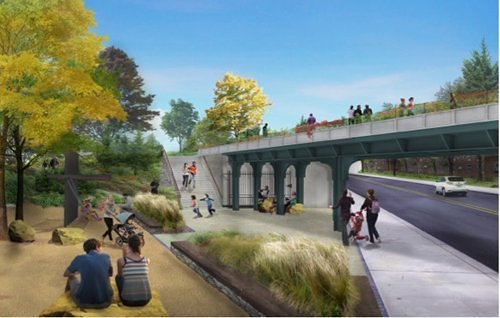Yet another High Line-esque project has been proposed, this time in Queens.
A blueprint has been developed for a 3.5-mile stretch of abandoned railroad tracks, which would connect Rego Park to Ozone Park with a walkway and bike path. This would also link the Gateway National Recreation Area to Forest Park, though indirectly.
The blueprint is part of a study released by the Trust for Public Land that included a cost breakdown and outlines for park's amenities, according to Curbed. The study prices the project, called the Queensway, at $122 million—this is less than the $152 million cost of the High Line phases 1 and 2. Funding, according to the study, might come from philanthropy, earned income, and public funding.
The Trust calculated that the park would draw as many as a million people annually, and would boost business for local shops and eateries.
The plan for the project was created by WXY Architecture + Urban Design and dlandstudio architecture.
Queensway is competing with a project to restore transit service on the track, formerly the Long Island Railroad Rockaway line. Neither has gotten support from the mayor yet, but the Queensway project has attracted support from other public officials. One such official is congresswoman Grace Meng, who said the project "has the potential to be the new gem of open space in the borough."
Check out renderings of the project below, courtesy of Curbed.
Related Stories
| Aug 11, 2010
Bronze Award: Alumni Gymnasium Renovation, Dartmouth College Hanover, N.H.
At a time when institutions of higher learning are spending tens of millions of dollars erecting massive, cutting-edge recreation and fitness centers, Dartmouth College in Hanover, N.H., decided to take a more modest, historical approach. Instead of building an ultra-grand new facility, the university chose to breathe new life into its landmark Alumni Gymnasium by transforming the outdated 99-y...
| Aug 11, 2010
Fleet Library, Rhode Island School of Design
When tasked with transforming an early 1920s Italian Renaissance bank building into a fully functional library for the Rhode Island School of Design, the Building Team for RISD's Fleet Library found itself at odds with the project's two main goals. On the one hand, the team would have to carefully restore and preserve the historic charm and ornate architectural details of the landmark space, d...
| Aug 11, 2010
Gold Award: The Lion House, Bronx Zoo Bronx, N.Y.
Astor Court sits at the heart of the 265-acre Bronx Zoo, and its six Beaux Arts buildings were constructed at the turn of the 20th century to house exotic animals from around the world. When the Lion House was built in 1903, the brick and limestone facility was considered state-of-the-art, but as standards of animal care advanced, the lions were moved into a more natural setting, and the Lion H...
| Aug 11, 2010
The pride of Pasadena
As a shining symbol of civic pride in Los Angeles County, Pasadena City Hall stood as the stately centerpiece of Pasadena's Civic Center since 1927. To the casual observer, the rectangular edifice, designed by San Francisco Classicists John Bakewell, Jr., and Arthur Brown, Jr., appeared to be aging gracefully.
| Aug 11, 2010
Platinum Award: Reviving Oakland's Uptown Showstopper
The story of the Fox Oakland Theater is like that of so many movie palaces of the early 20th century. Built in 1928 based on a Middle Eastern-influenced design by architect Charles Peter Weeks and engineer William Peyton Day, the 3,400-seat cinema flourished until the mid-1960s, when the trend toward smaller multiplex theaters took its toll on the Fox Oakland.













